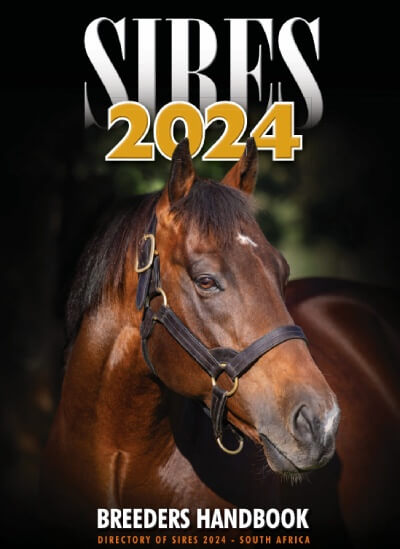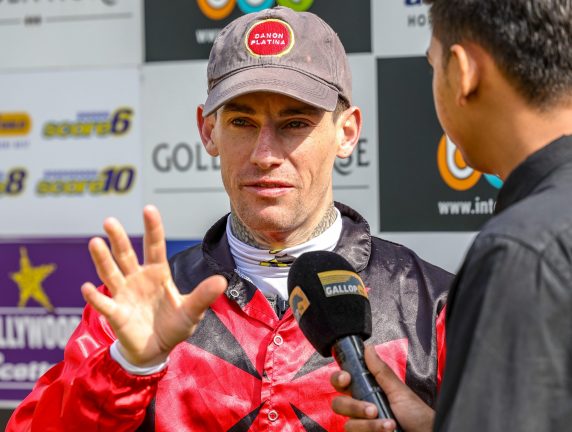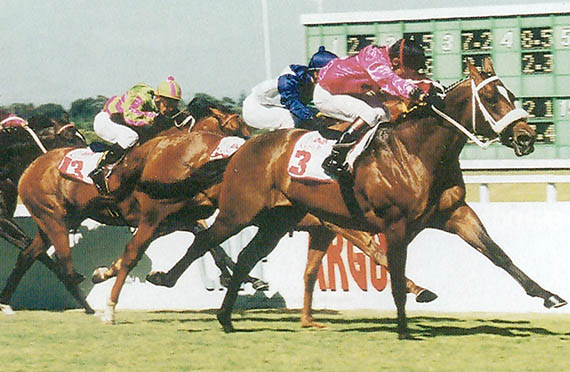
Captain Al wraps up the Gr1 Cape Argus Guineas
The Cape Guineas has been an integral source of champions on the colourful tapestry of South African horseracing for close on a century. Run for the first time in 1955 as the Cape Of Good Hope Guineas for a stake of £4200, the 2013 renewal boasts a stake of R1 million under the auspices of a proud and dynamic new sponsor.
The first Guineas winner Marion Island was bred by George Kramer at his Broadlands Stud and was raced by Mr & Mrs R Engestrom and Mr J Carney, who was also his trainer. The horse changed stables to Syd Garrett sometime after his Guineas win and went on to win the first of the £10 000 Mets in 1957. Those were certainly the days and a host of sponsors have branded the event over the ensuing years.
In 1963 Cape Mellow-wood came on board as sponsors until 1970. The race was sponsorless from 1971 to 1974. In line with the Cape Town Festival of 1975 the race was branded the Argus Festival Guineas and won by the brilliant son of Kirch Flambee, Gatecrasher.
The classic became the Richelieu Guineas in 1978 and in the next two decades had various sponsors from Topsport Bloodline, to Bloodstock South Africa and the Cape Premier Yearling Sale, most recently. And how far we have evolved as we race into the early stages of the 21st century.
Grand Parade Investments are the new sponsors and one of their Burger King outlets will serve the popular fast food to hungry racegoers on course in a concept that could just never have been imagined in the wildest dreams of anybody attending the opening event 58 years ago. In fact the term ‘fast food’ was only first recognized in a Merriam–Webster dictionary in 1951. The race that evolved into the Guineas actually dates back as far as 1927, when it was originally called the Western Province Derby.
It changed its name to the Western Province Guineas in 1945 and in 1955 became the Cape of Good Hope Guineas. The honour roll of winners boasts many of our most famous horses. Three of them, in Colorado King, Hawaii and Shah Abbas subsequently went to the United States, to continue their distinguished careers in the face of the world opposition. The first Guineas winner Marion Island went on to win the Met two years later.
The modern era of winners includes the galloping goldmine, Empress Club, and the current day stallions Horse Chestnut , Captain Al as well as the ill fated champion Jet Master. Both Jet Master and Captain Al have sons carrying their flag on Saturday.
The Guineas was the pinnacle event on the Milnerton Turf Club programme for a lifetime. The track where the ‘surf meets the turf’ boasted one of the best racing surfaces in Africa and this was borne out by the statistics which saw it host 52 meetings in 1978 . The Guineas was traditionally run on the first Saturday in February.
1979: Bold Tropic
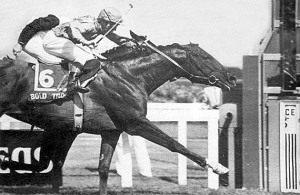
Bold Tropic
The sponsors of the R75 000 Richelieu Guineas regarded with justification as the country’s premier classic, are to be commended for having increased the stake once again, this time by R15 000, to ensure that it continued to attract the best of the three-year-olds. It did. Of the 16 runners five came from Natal, three from the Transvaal and one from Port Elizabeth – the most representative field in the then 25 years of the classic.
The race itself provided an unforgettable finish, with Michael Roberts riding a superb race to get the 2-1 favourite Bold Tropic past the post a short-neck in front of the Cape hope Horatius – Horatius, faultlessly ridden by Ken Michel, running a great race in defeat.
AS always, there was some jostling in the early stages – inevitable in a race over a sharp 1600 metres like the Guineas – but when the field settled down after covering a third of the distance Calvados and Outswinger were out in front to lead the way into the turn.
Michel moved Horatius into second place as the field came into the straight, with Bold Tropic also making up ground, and at the 400-metre marker there was nothing to separate Calvados, Horatius and Bold Tropic. Calvados was the first to falter, and over the final 300 metres Bold Tropic and Horatius drew away from the field, fighting it out stride-for-stride.
Bold Tropic edged into a three-quarter length lead, Roberts still riding with his hands, but Horatius never let up. With 100 metres to go Bold Tropic’s head went up. He appeared to have had enough. Roberts went for his stick, giving him several smacks, and Bold Tropic surged forward, his ears flat on his neck. As he did so, Horatius changed legs and came at him again, but Bold Tropic was able to hold his advantage to the post.
Bold Tropic, who carried the colours of Mr and Mrs Cyril Hurvitz, was bred by the Birch Brothers by Plum Bold out of the Herculaneum mare Tropicana out of the Fairthorn mare Floral.
1985: Prontisimo
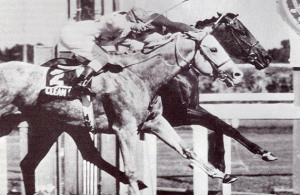
Prontisimo
In a season otherwise dominated by the visitors, the Richelieu Guineas developed into a spectacular fight between the Ralph Rixon-trained Clean Break, who had made all the running, and the Terrance Millard-trained Prontisimo, who was drawn one from the outside in a field of 16.
Speed, stamina and sheer guts got Prontisimo to the line a short head in front of Clean Break. Felix Coetzee must have had Prontisimo galloping as the stall gates opened for he surged a length clear of the field in a matter of strides, this enabling Coetzee to overcome Prontisimo’s disadvantageous draw and move him towards the inside rail. Coetzee allowed Clean Break and then Timbavati to go past Prontisimo after covering 300m.
Clean Break brought Timbavati into the straight with Prontisimo poised for his run just behind them. But Prontisimo’s early effort seemed to have taken its toll, for though he ranged alongside Clean Break half way up the straight he was unable to get the better of him.
Coetzee pulled out all the stops over the final 150m and Prontisimo, responding gamely, edged a neck clear. But Clean Break was by no means finished. With “Rooies” Fourie riding a most determined finish, Clean Break came again in the last strides and only a short-head separated them at the post. The fact that the third horse was nearly five lengths back speaks for the quality of the first two.
Mr and Mrs Laurie Jaffee and Mr Des Scott’s Prontisimo rated among the best winners of the Guineas in its 31-year history to that point – no small claim when one considers that its winners included such luminaries as Colorado King, Hawaii, In Full Flight and Politician. The Guineas was his sixth win from seven starts in the best company.
1988: Young England
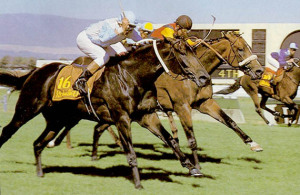
Young England
The Cape’s most promising line-up of three-year-olds at the start of the season augured well for the Richelieu Guineas, but when nominations fell due the classic was already being spoken of as a two-horse affair. For the first time in years there was no challenge from either Natal or the Transvaal in the Richelieu Guineas – trainer David Payne had made it clear that, though entered, Natal champion Sealegs (NZ) would not line up – and none of the locals now measured up to Terrance Millard’s Royal Chalice or Peter Kannemeyer’s Priceless Asset.
Royal Chalice had beaten Priceless Asset in the Summerveld Stakes during the Natal winter season, but Priceless Asset had won his five subsequent races, including the SA Invitation Stakes and the Basil Starke Stakes.
Meanwhile, Royal Chalice had raced only three times, but against much stronger opposition. He had failed by a short head to catch the brilliant Wexford Boy, subsequent winner of the Cape Flying Championship, he had trounced Young England in the Computaform Stakes, and then he had finished a creditable second to runaway Met winner Mark Anthony in the Queen’s Plate.
Everything looked set for a gigantic struggle between the two colts and the bookmakers priced up the Guineas as if it were a match, offering 10/1 upwards about the other 14 runners.
And the day belonged to Peter Kannemeyer . He won it with the least fancied of his three runners, 20/1 Young England, but he also filled third and fourth places with Coolstar and Priceless Asset, his patrons thus scooping R237 000 of the prize money – something for the record books. Young England had showed great potential earlier in his career, winning his first four races including two feature events; but in his recent performances he had not come up to expectation.
This, combined with his outside draw, had his former admirers looking elsewhere for the winner. But Young England defied the form book, he defied his outside draw, and he defied the south-easter gale; turning into the straight second last, he swooped on the leaders to snatch the race by a neck – a performance that rated with the most memorable Guineas victories.
Young England’s win also realized a long cherished dream for his owner, Johannesburg-based Mr Gerald Rosenberg, who had been a loyal supporter of Cape racing for many years, as was his father before him. When Young England won the Langerman Handicap under topweight of 58kg eight months earlier Mr Rosenberg expressed the hope that the colt would be good enough to win the Guineas. But he could not have foreseen the dramatic way his hope was to be realised.
Jockey Gavin Howes did not attempt to blitz Young England down the backstraight to get a good position going into the turn. Instead, he dropped him out and came over to the inside rail – tactics totally foreign to the Guineas.
Wise decision
Young England was second last on the turn and into the home straight, the new false rail throwing him to the centre of the track. Howes switched him to the outside for his run – a wise decision, for he now had the rest of the field blanketing him from the gale. Meanwhile, Royal Chalice had been chased up from his wide draw to third position on the turn and he brought the field into the home straight. But his early exertions quickly told and approaching the 400-marker he was a beaten horse.
Stable–companions Cool-star and Priceless Asset, who had come through on the inside rail, were left fighting for supremacy, and then Priceless Asset began to hang in on to the rail and falter. Young England’s time of 1 min 37,4 sec was excellent considering the force of the wind. Though 1,4 sec outside the course record, it was nevertheless the third fastest time recorded since the Guineas went metric.
If the Guineas was a triumph for owner, trainer and jockey, it was equally so for Young England’s breeder, Mr Guud van Heesch, of Hoog Eind Stud, for it gave him the distinction of having produced both the 1988 Met and Guineas winners. Like Met winner Mark Anthony, Young England is a son of Royal Prerogative (GB). He is out of Marcinda by Cindy’s Son out of the Australian mare Marsy.
New false rail
A footnote to the Guineas that year was that it was a very different race from Guineas of the past, and what made it so was the new false rail leading from the near-bend into the straight. This fanned out the field right across the track, giving every horse a chance in the home straight – something many horses were denied in the past unless well positioned going into the turn.
Whether Young England could have won from the tail of the field without the new false rail can only remain a matter of conjecture; but one this is certain: the Guineas draw and the early dash for position are no longer of paramount importance. The new false rail ensures a fairer race without taking the essential dash out of the classic and it would be a good thing to maintain it in future Guineas.
1990: Face North
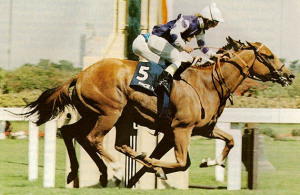
Face North
It was probably inevitable that the R300 000 Cape of Good Hope Guineas should have been regarded as rather low key in 1990, with the building of the new stand at Milnerton still in progress and no sponsor for the first time in 13 years.
The customary flamboyance and fanfare leading up to the Cape of Good Hope Guineas, the premier classic, were for the most part missing; the champagne gallops at the beginning of the week and the bookmakers’ callover at the end served as a reminder; but the Cape Turf Club made no secret of the fact that it was not looking to records at the gate or on the tote.
These can hardly have been expected in the circumstances. The concrete greyness of a building site and the steel and wire barricades surrounding it hardly engendered an atmosphere of gaiety and colour; besides, accommodation and viewing space, at best limited at Milnerton, were now at a premium. Even the club stewards had to be relegated to a marquee!
The remarkable thing was that Guineas Day surmounted all the many difficulties, while the race itself fully compensated racegoers for whatever discomforts and inconveniences they might have had to tolerate. The finish was the most rousing since the dramatic In Full Flight / Sentinel dead-heat of 1972 and was on a par with the Prontisimo (Arg) / Clean Break short-head struggle of 1985.
The field that contested the Guineas was far superior to that of the previous year and interest was added by the favourite, Pas de Quoi, and several fancied horses being drawn wide. This prompted the usual debate on their chances of overcoming their draws on the sharp near-bend 1600m, and Prontisimo (Arg) and Young England – two who had in recent years – were cited as proof that this could be done.
Certainly Pas de Quoi’s No. 15 draw in the field of 16 did not deter punters; he remained a 2/1 favourite from the time betting opened to the day of the race when he firmed to 17/10. This confidence was hardly surprising. Unbeaten in his five starts, Pas de Quoi had displayed the essentials needed to win the Guineas: speed and stamina. But in the end it was the draw and the courageous performance of the Natal-trained Face North that were his undoing.
In a thriller, Pas de Quoi held a slight advantage, no more than a neck approaching the final 200m, with Face North pressing him. Eric Chelin had his stick out and Pas de Quoi was giving his all, but it was apparent that Face North, under a great ride by Kevin Shea, still had a bit to come. Stretching to his maximum, Face North stole a little ground with every stride and three strides from the post was alongside and edging to a short-head victory.
Tremendous performance
It was a tremendous performance by Face North, equally by Pas de Quoi, and it says much for them that they finished 3 lengths clear of the rest of the field. The time of 1 minute 37,2 seconds was 1,2 seconds outside the record, but excellent time into a fresh southeaster and equal to that set by dead-heaters In Full Flight and Sentinel and also by Prontisimo (Arg).
Face North’s win was a triumph for then Natal based trainer Vaughan Marshall, who saddled the 1986 Guineas winner Sea Warrior. A winner of his three previous races, Face North started his career with Terrance Millard before being sent to Port Elizabeth and the satellite yard of Marshall.
Owners Tony Ross and Adrian Gardiner described Face North after his Guineas victory as “the ugly duckling that nobody wanted.” Face North was bred by Coromandel thoroughbred Stud by Northfields (USA) out of the Brer Rabbit (GB) mare Shadow Queen whose dam Lady Zia (Preamble II (GB)) produced Quarrytown, 1980 Horse of the Year. Incidentally, Quarrytown’s 12 wins included the Cape Guineas.
Of course the wind blew throughout the afternoon, as it inevitably does on Guineas Day, but at least it was not a flagpole-bending southeaster, and it did help to ease the humidity. The only pity was that it carried a haze of smoke across the course from a veld fire nearby and this muted what colour there was, women’s fashion, jockey’s silks and the like.
At the end of the day the Cape Turf Club had reason to congratulate itself. In spite of the difficulties it faced everything had gone well. Its track had looked superb in spite of the heat and wind of the previous weeks; there had been a good turnout of racegoers; the most had been made of the facilities available; and overall tote turnover was a remarkable 7% up on the previous year.
As the chairman, Jeff Bub, told racegoers at the presentation of the Guineas trophies: “Our stand will be completed this year. At next year’s Guineas the Cape Turf Club will give you the best at Milnerton.”






